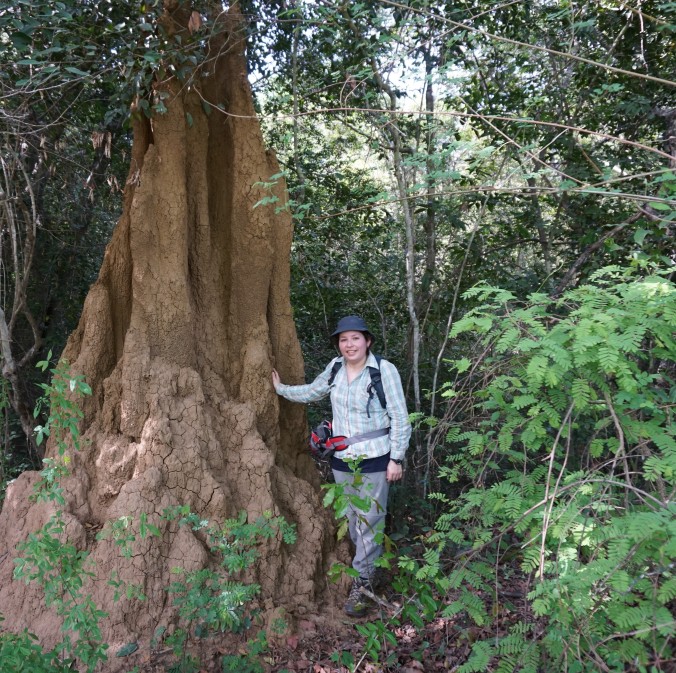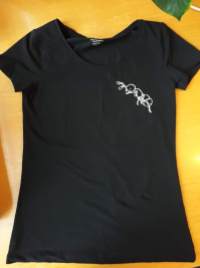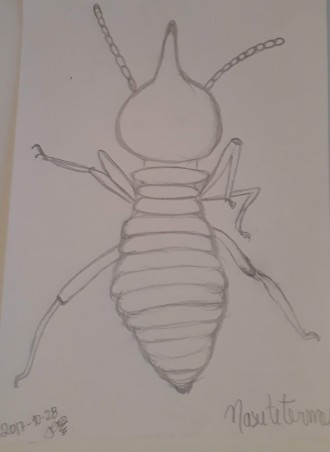
Scientists around the world are being affected in unforeseen ways by the COVID-19 pandemic. Whether they’re working from home, being forced to pause or terminate research projects, or losing their job altogether, researchers are meeting novel challenges and given no choice other than to adapt. For some, stay-at-home orders offer time to learn new skills and work on data analysis and writing projects that otherwise would have been on the back burner for the foreseeable future. For others, their experiments are taking a toll in irreversible ways. Whatever your experience, we know that everyone in our community of social insect scientists is facing challenges and doing their best to cope during this time. We asked some researchers to share their experiences in hopes of providing comfort to those of you experiencing similar things and to continue the conversation amongst our community.

Are you working right now, and if so, where?
“I am working from my home near Tufts University, just north of Boston, MA. With the current situation, I am unable to travel to my field site in Washington. Thankfully, two WSU field technicians, Jason and June, are local to the prairie we work on. Between analysing data and writing from home, I virtually meet with Jason and June to go over protocols for data collection, entry, etc. As long as Jason and June can social distance while in the field (which is pretty easy on the 180-acre prairie) and healthy, my data is getting collected! While I am grateful for this, my makeshift home office using my husband’s childhood desk is not as enjoyable as fieldwork.” –Dr. Rachael E. Bonoan, Postdoctoral Researcher, Tufts University & Washington State University

Rachael’s makeshift home office
“Ha! Work. Yes. I’m attempting to work from home.” –Dr. Tommy Czaczkes, Animal Comparative Economics Group leader, University of Regensberg
How has the COVID-19 outbreak impacted your scientific research/teaching?
“I am lucky to have a lab with large numbers of reared termite colonies. I was able in the past 7 years to create from mating pairs more than 500 colonies, many of them are held in large containers. I think we have more than 25 million termites under our roof, which comes with many opportunities, but also responsibility and limitation. Space is the major limitation, or so I thought. I now fully realize that our main limitation is: time. I need the time (and the time from technicians) to maintain these colonies. Normally, we have 1 technician full time to keep these colonies feed, moist, and contained. Now, we currently have a single person coming once a week, just to check and minimal maintenance. Mostly to keep them from escaping (Coptotermes is good at that!), making sure that colonies are not starving, and that humidity levels are where they should be. I expect the loss of a few colonies by the end of this pandemic. We will try to minimize this loss, as colonies will probably be on life support until they can get back to their initial expected logistical growth. However, it is not just the lab access limitation. I have many field projects, all in city and state parks. All of them are closed, which means, I have no access to these sites to collect the data. ” -Dr. Thomas Chouvenc, Urban Entomology Assistant Professor, University of Florida IFAS Ft Lauderdale Research and Education Center
“At present, I am not teaching any courses because I have a Research Professorship. My current work consists of data analysis and writing of manuscripts, books, and general articles. At least in the short run, my work has benefited from the absence of commuting and travelling for committee work. At the same time, I am having no difficulty interacting with my students and post-docs, virtually. I also have more time for reading and I am able to read books that I would normally consider a luxury. Yes, we have had to discontinue two major experiments and were forced to release the wasps back into nature. I am confident though that we will resume those experiments next year.” -Dr. Raghavendra Gadagkar, DST Year of Science Chair Professor, Indian Institute of Science Centre for Ecological Studies
“I am in the unique position that I am an emeritus scientist who has no ongoing students, teaching, administrative duties, or laboratory access that is restricted by the virus. My laboratory contains only my personal research operation. Thus, no physical distancing problem and no new social isolation. In my case, COVID-19 has not negatively affected my work. Oh, I could quibble that getting some supplies and materials, and that contacting colleagues has been hampered, but so far toilet paper has not been a problem! I always like to look at the brighter side of any situation. There is a brighter side to the COVID-19 experience. I personally have benefited from this opportunity via receiving faster reviews and, in turn, had the time to complete the revisions more quickly.” -Dr. Justin Schmidt, Southwestern Biological Institute & Department of Entomology, University of Arizona
“Our university does not allow official travel and has closed our field stations, so I have abandoned the 2020 field seasons for two projects, one monitoring the spread of a non-native ant in Texas and the other on a locally social parasitic ant. I will still be able to publish, but with less data than I’d like. We have also ceased most general collecting for the UT collection. I was teaching a small, 15 student class this semester, but the transition to online teaching has taken more time than I had anticipated, especially as we redesigned student projects and re-did many of the lectures. Fortunately, I co-teach this class with my wife, so we are both able to do this together from home. I have also cancelled two photography workshops, two outreach events, and an invited seminar at another university.” -Dr. Alex Wild, Curator, University of Texas Insect Collection
“While my data is still being collected, I am not able to be in the field myself. [WSU field technicians] Jason and June are doing a fantastic job but as a field biologist, this is tough for me. Especially since I love my prairie field site, bursting with wildflowers, and the WSU folks I spend time with when I am there. I have worked with Jason and June to ensure we have enough supplies to avoid sharing clipboards, butterfly nets, etc. and to pare down experiments to allow for social distancing and if necessary, an abrupt break in data collection.” -Rachael

Rachael with field team
“Luckily for me, I don’t have to do any structured teaching. But my research has completely ground to a halt. As my group works almost exclusively on foraging, our work is very seasonal. Spring and early summer are the very best time to collect data – the ants are so motivated! Indeed, for sensitive experiments, I am reluctant to collect data any later than September. We had just started a 6-month collaboration with a visiting Ph.D. student, who had to cancel everything. I’m worried that, even if everything opens, we can’t just start at the drop of a hat. Indeed, if the shut-down goes on until June, we might lose the whole season. Oh yes, and for the first time, I had to withdraw a paper from review. We were asked to perform a minor control – three weeks of work or less – but then COVID-19 hit. Happily, the first author has a post-doc (or had – he returned home with COVID-19), but this is quite a blow for him too.” -Tommy
How do you cope with social distancing? Are you alone at home or do you live with others?
“As an extroverted social insect scientist and field biologist, social distancing and staying home has been mentally and emotionally difficult. It has also been physically difficult—it took working from home for only one week to realize how comfortable my desk as school is! Thankfully, I do have my husband with me to remind me to take a break to stretch or go for a walk around the block. To cope, I am trying to keep as much of a “normal” routine during the workweek as possible. I work out in our basement like I would normally do before going to work, I make tea and watch some of the Today Show (big Al Roker fan), and then I “go” to work. If the weather is nice, I take an afternoon break to go for a walk. At Tufts, I work in an open office space with about ten other post-docs/grad students. One of the students set up an “office” Discord channel (online chat), which has been nice for keeping in touch and asking questions about stats, writing, etc. like we would if we were in our shared space.” -Rachael
“Ah, it’s not so bad! I have a wife and two lovely kids (6 and 3), so I am far from alone. Indeed, now that all my friends (most of which are far from where I live) are getting involved in video chats, I’ve had a lot more social contact! I’ve had lovely chats with friends I have not spoken to in years – in one case over a decade!” -Tommy
“My wife and I live by ourselves in our home and we are fortunate to be able to get all that we need delivered to our doorstep.” -Raghavendra
“I am home with my partner and our two young children. I have enjoyed the close time with our children; earlier this week our 3-year-old wrote his name for the first time, and our 6-year-old has been raising caterpillars. It’s been really nice, to be honest. However, I devote more time to childcare and home-schooling than any other activity, by a large margin, and given social distancing and school closures we do not have external childcare. So my actual work time is reduced by half, at least.” -Alex
What platform do you and your colleagues use to stay in touch (e.g. Skype, Zoom, etc.)?
“Oh, let’s face it, they’re all pretty much the same… (3-year-old comes in: “Robin hit me!” “oh dear, do you want to do a puzzle in the office?”… etc, etc… ok, I’m back). The ad-hoc nature of houseparty has been quite fun.” -Tommy
If you are working from home, are you working on the same things as usual?
“Experiments have stopped, travel has stopped, but reading and writing have become intensified, more diverse, and more pleasurable.” -Raghavendra
“I can keep up with some of the administrative tasks of the UT collection from home, as well as the odd journal reviews and collaborations. But in general, I am unable to perform many of my regular curatorial responsibilities as those involve physical work in the collection itself. I am still doing some work on our database, but so much of my much-reduced work time is given over to online teaching that I probably have no more than 3-4 hours per week of curation-related work. I write more for our department’s blog than normal.” -Alex
Have the restrictions due to COVID-19 had any positive side effects for your research, for example, time to learn a new skill?
“Yes, actually! I have finally taken the time to learn to do data management, data visualisation, and statistical workflow reporting in R. I have been putting this off since the start of my Ph.D., so it’s about time! My next paper will have shiny ggplot2 figures, and an HTML file giving the entire code and output of my analysis. I’ve still not caught up to my (ex) Ph.D. students, but I’m making progress. It has been a lot more fun than I thought it would be.” -Tommy
What activities or hobbies are you currently doing to fill your time?
“To fill my time, I have been doing a lot of cooking and baking. One of my favourite de-stressing activities is watching The Great British Baking Show while cooking dinner or baking dessert. While I have yet to try anything as technical as they have on that show, I have been practicing baking bread! This weekend, I am going to attempt Portuguese sweet bread, a hometown Easter treat. I am also using this time to do virtual outreach. My husband and I recently wrote a kid’s story, “Dress Like a Scientist Day,” and have been working with an illustrator. Now that we have illustrations, I am creating a website so kids can read the illustrated story and learn about the diverse “uniforms” in science as a free eBook!” -Rachael
“During this time at home, I was hoping to catch up with data analysis and writing, but being a dad of a 4yr-old, it is now established that I will get nothing accomplished. I am therefore converting my time as a backyard entomologist to show my daughter the wonders of our yard: termite swarms, invasive ants (15 of them in my yard alone, welcome to south Florida), wasps, bees, mole crickets, flies, mosquitoes, planthoppers… A lot of fun, and learning about why bugs are cool.” -Thomas

Thomas Chouvenc’s office these days. He’s taking advantage of this lockdown to get better at photography and video editing.
“I spend an hour every day engaged in what people might consider ‘silly art’, just to keep my creativity flowing!” -Raghavendra
Do you have any tips for readers on how best to cope with the restrictions the COVID-19 outbreak has imposed on your scientific work or private life?
“I need structure to be productive. If you can relate, I suggest keeping as much of a routine as possible and using a planner to block out your day. I swear by my Passion Planner, which has each day broken down into half-hour blocks, and space to plan both work and personal goals. You can try the Passion Planner for free with their downloadable PDFs. My favourite pens for writing in my Passion Planner are FriXion erasable pens—they allow for color-coding and keeping things neat when your schedule shifts around (as it does). A game-changer for me with video meetings is to add all recurring meetings (which seem to keep multiplying), with their meeting links, to my email calendar. This way, I get a reminder (with the link!) 15 minutes before the meeting starts and I am not searching through my email for what feels like forever. For each video meeting, I try to get up and go to another room as possible. This way, I get a bit of a change of scenery and I am not sitting at my desk all day. Outside of work, make sure to stay connected with friends and family as much as possible, whether it be through text, phone, video, online gaming, etc. Like a colony of social insects, the only way we are going to get through this is by working together.” –Rachael

“Don’t expect too much – especially if you have children. I have heard from colleagues, especially in the US, that there is often an atmosphere of “we’re getting on and being productive, so you should be too.” This sounds pretty toxic. We also see a lot of social media about people putting together online seminars, organising e-journal clubs, and so on. This is great! But this should not be considered ‘normal’. Normal – especially with kids at home – is having a pleasant day. Everything else is bonus.” -Tommy
“Most of us in academia usually have so much backlog and are always putting off some of the most pleasurable reading and writing, owing to demands on our time, that temporary lockdowns can have very positive effects, as long as our basic needs are taken care of.” -Raghavendra
“Everyone should recognize the nature of this crisis and not set goals for themselves beyond maintaining basic mental and physical health. We also need to be aware that this crisis is just beginning. The downstream economic effects have the potential to be far more destructive to our fields than a few weeks of sheltering in place.” -Alex
Anything else you would like to share about how COVID-19 has affected your work and life as a scientist?
“Mostly, it has emphasised again how lucky we are, as scientists. I don’t have a business that will go bankrupt. I will continue to be paid. The German Science Foundation is even offering 3-month no-questions-asked grant and salary extensions for many of the researchers it funds. I can even, in principle, be productive from home. Honestly, I couldn’t ask for more.” -Tommy
“I realise of course that I might have had a very different perspective if I were a young Assistant Professor with two young children! But I see that even people in that situation I know are coping very well. Generally, I think scientists are far too busy doing more and more of the same thing, affording no time for continued broad education in the humanities, culture, and philosophy. This is an opportunity for course-correction.” -Raghavendra
“I am seeing the value in our department’s epidemiologists, now more than ever.” -Alex





















